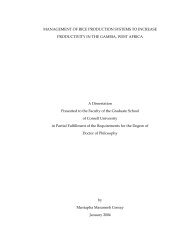Revised proceedings - The System of Rice Intensification - Cornell ...
Revised proceedings - The System of Rice Intensification - Cornell ...
Revised proceedings - The System of Rice Intensification - Cornell ...
You also want an ePaper? Increase the reach of your titles
YUMPU automatically turns print PDFs into web optimized ePapers that Google loves.
<strong>The</strong> large-scale expansion <strong>of</strong> SRI in Tripura was possible due the mass movement that emerged to support<br />
SRI by the State Government and Panchayati Raj institutions with active farmer support. For promotion <strong>of</strong><br />
SRI, the state government contributed a little less than 50% <strong>of</strong> the cost in the demonstration plots.<br />
In the introductory part <strong>of</strong> his paper, Dr. Majumder presented how better rice cultivation has evolved<br />
through relentless efforts <strong>of</strong> farmers just through their observations and experimentation. He lamented that<br />
“contemporary irrigated rice cultivation has become quite uniform with a standard set <strong>of</strong> practices,” preferred<br />
by scientists who were pleased with high external inputs. But in recent years there has been a diminished yield<br />
growth rate reaching a plateau.<br />
Seeing this decreasing yield rate and plateau for further increases underscores the importance <strong>of</strong> SRI at the<br />
moment. With all good intentions and satisfied with a few decades <strong>of</strong> increase in yield, the Green Revolution<br />
has ignored indigenous rice varieties, has increased external input use and farmers' financial dependence, and<br />
all this has affected bio-diversity and is contributing to adverse climate change impacts.<br />
Dr. Majumder pointed out that “SRI is quite different from the approach <strong>of</strong> the Green Revolution in that:<br />
a) It is not a seed-based approach,<br />
b) It makes reductions in inputs such as seeds, water, fertilizers, and labour and yet gives more yield, and<br />
c) It originated outside <strong>of</strong> the established scientific institutions.”<br />
Farmers‟ experience has proven that SRI brings in higher resource-efficient productivity, which is good for<br />
the farmers, the soil and the rice plant itself. All the participants were impressed and regretted his absence<br />
because they would have liked further clarifications from him on SRI success in Tripura State.<br />
A gist <strong>of</strong> the paper submitted by Dr. Majumder titled “<strong>System</strong> <strong>of</strong> <strong>Rice</strong> <strong>Intensification</strong> (SRI) – A Traditional<br />
Method <strong>of</strong> <strong>Rice</strong> Cultivation <strong>of</strong> India?” was also presented by Pr<strong>of</strong>. Husain. <strong>The</strong> main theme <strong>of</strong> the paper was<br />
that a method <strong>of</strong> single seedling planting <strong>of</strong> paddy, close to the present-day SRI method <strong>of</strong> cultivation was<br />
developed by farmers <strong>of</strong> Tamil Nadu, India, about a hundred years ago. This practice, along with another<br />
farmer-devised version <strong>of</strong> the single-seeding practice, called Gaza planting, which involved a detailed package<br />
<strong>of</strong> practices, was also introduced during the first decade <strong>of</strong> the twentieth century. Main features included<br />
single seedling planting, row planting, use <strong>of</strong> organic manure, weeding, and economic water management.<br />
<strong>The</strong>se practices were closely similar to the present SRI practice. However, one concept <strong>of</strong> SRI, namely early<br />
transplanting was not there in this practice; and the concept <strong>of</strong> soil aeration was also not well understood. <strong>The</strong><br />
method had resulted in substantial increase in yield. He mentioned that after two to three decades <strong>of</strong> its<br />
introduction, these systems apparently seemed to have gradually given way to somewhat different practices,<br />
the reasons for which are unknown. However, he mentioned that “seeing these historic „echoes‟ could make it<br />
relatively easier to promote SRI today. <strong>The</strong> intention <strong>of</strong> this paper is not to suggest that SRI originated in<br />
India. Rather we wanted to document that many <strong>of</strong> its practices have been utilised in India long ago, and<br />
farmers were able to use them quite successfully. <strong>The</strong> paper does not diminish the importance <strong>of</strong> SRI but<br />
rather shows that it is grounded in biological potentials and realities that have existed in the rice genome for<br />
millennia.” (This interesting paper is attached in Annex 2.1 (b) for the benefit <strong>of</strong> the readers.)<br />
4.3 A.B.S. Sarker’s SRI Research at BRRI<br />
Abu Bakar Siddique Sarker, a Senior Scientific Officer <strong>of</strong> BRRI, briefly narrated preliminary findings from his<br />
Ph.D. research study conducted on SRI production and management practices during three consecutive Boro<br />
seasons.<br />
<strong>The</strong> study found that SRI methods result in a proven increase in rice yield. Average SRI yields were around 2<br />
tons/ha higher than conventional yield. He briefly stated the different advantages <strong>of</strong> the SRI practice, and his<br />
7

















